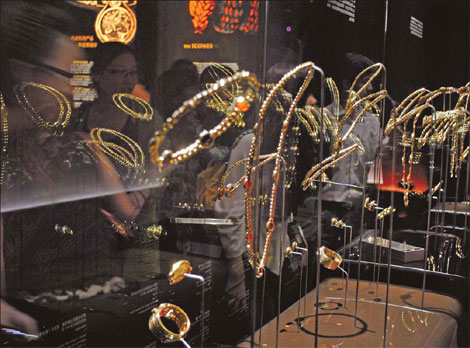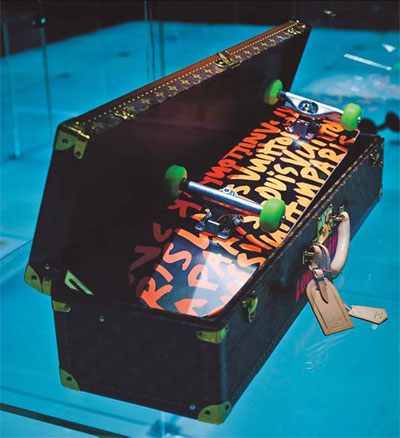Guile behind the glitter
Updated: 2011-10-12 07:54
By Gan Tian (China Daily)
|
|||||||||
|
Italian jeweler Bulgari's exhibition 125 Years of Italian Magnificence in Beijing. Wang Yanping / For China Daily |
Are exhibitions hosted by luxury labels just another way of promoting high-end fashion accessories? Gan Tian wades into a raging controversy.
Jonathan Jones, who writes on art for The Guardian, published a blog in May, titled, "Why cuisine or couture can never equal great art?" "Food is to be swallowed and clothes are to be worn," he commented. But some fashion labels, especially luxury houses, it appears, disagree. They believe their products are nothing short of works of art. Just days after Jones published his blog, Louis Vuitton announced the opening of its exhibition Voyages at the National Museum of China (NMC), that ran from end-May to end-August.
At the same time, Swiss watchmaker Vacheron Constantin held its first-ever exhibition, Treasures of Vacheron Constantin - A Legacy of Watchmaking Since 1755, at the National Museum of Singapore, which featured more than 180 watches.
And now, Italian jeweler Bulgari, is holding its exhibition titled, 125 Years of Italian Magnificence, at the NMC, which will run until Nov 3.
Although these exhibitions stress they "showcase a 150-year history of craftsmanship and innovation", and "illustrate the evolution of the watch-making industry and its advanced craftsmanship from the 18th century", museum-goers can't help wondering if they not just clever marketing.
At the opening ceremony of Vacheron Constantin's exhibition, a Chinese reporter asked the label's CEO Juan Carlos Torres: "Do you think there is now a new trend of luxury brands promoting their products in new markets (like Asia) by holding exhibitions?"
"A good question," Torres said. "But I don't think Vacheron Constantin's exhibition is promotion. It's only the desire to share."
Added Lee Chor Lin, director of the National Museum of Singapore, "The museum is really to connect the history of the people. In this museum, we present Singapore in a huge way. We believe that we can learn history through many things - fashion, photography, film, and food. So why not watches?
And when the reporter insisted on questioning the exhibition's value, Lee joked: "You are obviously not a watch wearer."
Meanwhile, at Beijing's NMC, curator of the Bulgari exhibition, Amanda Triossi, says the exhibition is more than just about jewelry per se. It will "reverse people's narrow mindset" about jewelry's lack of seriousness, she says.
However, 39-year-old frequent museum-goer Wang Kaisheng is unimpressed. He says the exhibits have no real art value, and only serve to trigger a longing for a flashy lifestyle.
"Museums have a mission to educate the public about art. A luxurious lifestyle may be easily accessible to Westerners but for most Chinese it is a pipedream," Wang says, pointing to a group of poorly dressed visitors gawking at the stunning jewelry pieces.
"As to the 10 yuan ($1.57) additional entry fee, isn't it evidence of these luxury houses' arrogance?" he asks angrily.
Taking these criticisms in his stride, Chen Lusheng, vice director of NMC, said in an interview with Wenhui Daily: "What really matters is the 'spirit' of the National Museum of China. Our spirit lies in variety. Bulgari's exhibition runs for three or four months, but we also have exhibitions on traditional Chinese culture, which run for three to five years. We want to give audiences more choice," Chen says.
In the same vein, NMC director Lu Zhangshen told China Culture News that the Louis Vuitton exhibition was just a small part of the museum's exhibitions. "People think Louis Vuitton is a luxury label, but NMC pays much more attention to its theory in designs Think about it, silk, porcelain, jade and bronze ware were also luxury items at some time, but are the mainstay of exhibitions today," Lu says.
Yang Tingting, fashion reporter for The Economic Observer, who has attended all three exhibitions, says: "Even if the labels' logos on the products disappear, they are still worthy of being exhibited in a museum."
She reserves her highest praise for the Vacheron Constantin exhibition in Singapore, pointing out that by "revealing the history of the whole industry in Europe", it has helped educate Asians.
The Guardian's Jones begs to differ, though. In his blog, he asks readers to compare a still-life painting of food with a real plate of food.
"The painting is very obviously not food - it does not give what food gives. But it does nourish something deeper instead. It reaches parts of us that chefs and couturiers cannot reach," he writes.
It is perhaps the same with luxurious products. A Bulgari necklace, despite its beauty and elegance, can never reach the parts of us that an artist can.
"Art is of the mind; it is ethereal. Everything it gives us it gives to our brains. Fashion and food fail to be serious art because they are trapped in the physical world," he writes.
|
A Louis Vuitton trunk with a skateboard is on display at the exhibition Voyages. [Zhang Tao / China Daily] |











